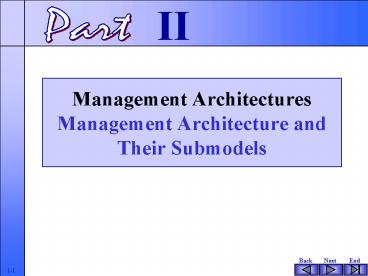Management Architectures Management Architecture and Their Submodels - PowerPoint PPT Presentation
1 / 12
Title:
Management Architectures Management Architecture and Their Submodels
Description:
The methods used for modeling and describing management objects ... into management function areas (configuration, fault, accounting management) ... – PowerPoint PPT presentation
Number of Views:137
Avg rating:3.0/5.0
Title: Management Architectures Management Architecture and Their Submodels
1
Management Architectures Management Architecture
and Their Submodels
II
Part
2
Management Architecture and Their Submodels
Chapter 4
3
Learning Objectives
- Architectures as the Prerequisite for Open
Platforms - Information Model
- Organizational Model
- Communication Model
- Functional Model
- Chapter Summary
4
Management Architectures and Their Submodels
- Management Platform is
- The framework for management relevant standards
- Architectures as the prerequisite for Open
Platforms (3 fundamental approaches) - Isolated approach
- Isolated tools for each management problems
(tools work independently of one another) - Coordinated approach
- Coordinated tools complementing each other to a
function) - Integrated approach
- Integration of tools in heterogeneous environment
providing non-vendor-dependent information. - Open management platforms form the basis for an
integrated approach
5
Management Architectures and Their Submodels
- Management Platform on a multivendor basis must
have - Description of managed objects (IM)
- Treatment and support of organizational aspects,
roles, and cooperation forms( OM) - Description of communication processes for
management purposes (CM) - Structuring of management functionality (FM)
- A framework for management relevant standards
with respect the above four aspects is called
management architecture.
6
Information Model
- IM controls
- The methods used for modeling and describing
management objects - Managed objects represent the characteristics
of the resources on which management operates - MIB (management information base) describe the
set of managed objects managed by a manager or an
agent system - IM of a management architecture defines the
entity, data type, object orientation - For Management interoperability to be success,
heterogeneous networked systems must interact
meaningfully with management purposes - Standard Management models established
prerequisites for management interoperability
7
Organizational Model
- OM controls
- There are different structures that forms the
organizational architectures Management
architectures should encourage the variety of
forms that characterized the organizations by
providing options for adaptation - The architectures enables forms of cooperation,
roles, and ways groups are organized - Topological and Functions of Management System
- Multipoint control, Multicenter control,
Hierarchical management, Central management, and
Network of managers Figure 4.4 -page 111 - Central management One MS is responsible for
all tasks (having multipoint control)
8
Organizational Model
- OM controls
- The organization model of a management
architecture defines the actors, their roles, and
the fundamental principles of their cooperation - Two forms of management cooperation
- The manage-agent model (asymmetrical-hierarchical)
cooperation form assumes a customer-provider
relationship for its cooperation (like
client-server relation) - The completely (symmetrical) cooperation form
that emanates from the communication and
cooperation of equal objects - OM domains concept define management views of
groups of resources - OM policy concept define domain-specific
management rules - Communication Model
- Management (monitoring and control of potentially
physically dispersed resources) - CM of management architecture is the exchange of
information between the actors
9
Communication Model
- CM controls
- Communication takes place
- Through an exchange of the control information
about a managed resource or object (controlling).
Manager! - Through a status request (monitoring). Manager!
- Through asynchronous event messages in the system
- CM deals with the following aspects
- Specify the communication partners
- Specify the communication mechanism
- Define the syntax and semantics (exchange
formats) - Embed management protocols
10
Functional Model
- FM controls
- FM of management architecture divides the
complexity of management into management function
areas (configuration, fault, accounting
management) - FM provides the basis for the management building
block - Stepwise refinement is the approach taken to the
development of function and service modules - Management by delegation allows for flexibility
and scalability - CM deals with the following aspects
11
Summary
Key Terms
- Coordinated approach
- Integrated approach
- Resources
- Objects
- IM (Information model)
- OM
- CM
- FM
- Management architecture
- Open architecture
- Management Platform
- OSI Management
- TMN
- ITU-T
- SNMP
- Desktop management interface
- Isolated approach
12
Next
Management Architecture
Chapter 5































